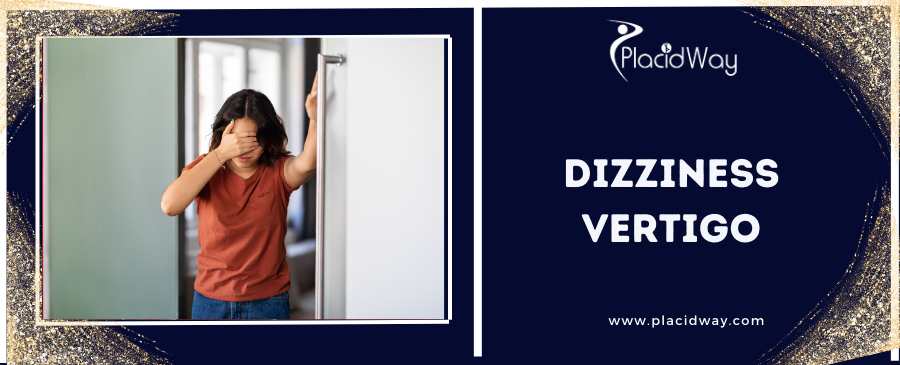
Reclaim Your Stability: Comprehensive Solutions for Dizziness and Vertigo
Feeling like the world is spinning, or constantly battling an unsettling sense of lightheadedness? Dizziness and vertigo are more than just inconvenient; they can severely impact your daily life, making simple tasks challenging and eroding your confidence. These conditions, which range from mild discomfort to debilitating episodes, often leave individuals searching for effective, lasting solutions.
While dizziness is a general term describing feelings of faintness, unsteadiness, or lightheadedness, vertigo specifically refers to the sensation that you or your surroundings are spinning or moving. Both can arise from a multitude of causes, often rooted in inner ear disorders, neurological issues, or even certain medications.
For many, finding timely and specialized care locally can be a challenge. This is where medical tourism offers a beacon of hope. Patients worldwide are increasingly looking for dizziness treatment abroad and vertigo remedies overseas to access advanced diagnostic tools, expert specialists, and innovative therapies that might not be readily available or affordable in their home countries. Whether it's the renowned Vestibular Rehabilitation Therapy (VRT), precise diagnostic evaluations, or even surgical interventions, international clinics are offering comprehensive solutions to help you regain your balance and quality of life. Explore how finding the best vertigo clinics globally can be your path to lasting relief and stability.
What are the common symptoms of dizziness and vertigo?
Understanding the distinction between dizziness and vertigo is crucial for accurate diagnosis and treatment. While often used interchangeably, they describe different sensations:
- Dizziness: This is a broader term encompassing several sensations, including:
- Lightheadedness: Feeling faint or as if you might pass out.
- Unsteadiness or imbalance: Feeling wobbly or like you might fall, particularly when walking.
- Wooziness or faintness: A general sensation of being unwell or foggy in the head.
- Vertigo: This is a specific type of dizziness characterized by a sensation of spinning, either of yourself or your surroundings. People often describe it as feeling like the "room is spinning" or they are "rocking on a boat." Vertigo can be debilitating and often accompanied by:
- Nausea and vomiting
- Loss of balance, making standing or walking difficult
- Nystagmus (abnormal eye movements)
If you're experiencing any of these dizziness symptoms or vertigo signs, especially if they are persistent or severe, seeking a medical evaluation is essential to determine the underlying cause and appropriate treatment.
What commonly causes dizziness and vertigo?
The vestibular system, which includes parts of the inner ear and brain, plays a critical role in balance. Disruptions to this system are often the primary causes of vertigo and dizziness. However, numerous other factors can contribute:
- Inner Ear Disorders:
- Benign Paroxysmal Positional Vertigo (BPPV): The most common cause of vertigo, triggered by specific head movements, due to dislodged calcium carbonate crystals (otoconia) in the inner ear.
- Meniere's Disease: A chronic condition causing episodes of severe vertigo, fluctuating hearing loss, tinnitus (ringing in the ear), and aural fullness.
- Vestibular Neuritis or Labyrinthitis: Inflammation of the inner ear (labyrinth) or the vestibular nerve, often viral, leading to sudden, severe vertigo, nausea, and balance issues. Labyrinthitis also involves hearing loss.
- Migraines: Vestibular migraines can cause vertigo or dizziness even without a headache, often accompanied by sensitivity to light or sound.
- Neurological Conditions: Strokes, multiple sclerosis, or tumors can affect balance pathways in the brain.
- Circulatory Problems:
- Orthostatic Hypotension: A sudden drop in blood pressure when standing up, leading to lightheadedness.
- Poor circulation: Conditions like heart disease or anemia can reduce blood flow to the brain.
- Medication Side Effects: Certain drugs, including antidepressants, sedatives, blood pressure medications, and some pain relievers, can cause dizziness.
- Anxiety and Stress: Panic attacks and generalized anxiety can manifest as dizziness or unsteadiness.
When you ask, "why do I feel dizzy?" or "what causes vertigo?" a thorough diagnostic workup, often involving an ENT specialist or neurologist, is essential to pinpoint the exact issue, especially if inner ear problems are suspected.
What types of treatments are available for dizziness and vertigo?
The good news is that many effective vertigo treatment options exist, tailored to the specific diagnosis:
- Vestibular Rehabilitation Therapy (VRT): This is a specialized form of physical therapy designed to retrain the brain to compensate for inner ear deficits. A therapist guides you through exercises that improve balance, reduce dizziness, and improve coordination. It's often the cornerstone for chronic dizziness and vertigo.
- Particle Repositioning Maneuvers (e.g., Epley Maneuver): For BPPV, specific head and body movements can effectively reposition the dislodged inner ear crystals. The Epley maneuver is often highly effective, providing immediate relief for many patients.
- Medications:
- Anti-nausea/anti-vertigo drugs: Medications like meclizine or dimenhydrinate can help alleviate acute symptoms but are not long-term solutions.
- Steroids: May be prescribed for inflammatory conditions like labyrinthitis.
- Diuretics: For Meniere's disease, to reduce fluid buildup in the inner ear.
- Migraine medications: For vestibular migraines, including preventative and acute treatments.
- Lifestyle and Dietary Modifications:
- Reducing salt intake, caffeine, and alcohol can help manage Meniere's disease.
- Avoiding triggers for migraines.
- Stress management techniques.
- Surgery: Reserved for severe, debilitating cases that don't respond to conservative treatments, particularly for Meniere's disease or certain inner ear issues. Options include:
- Endolymphatic sac decompression: To relieve fluid pressure in the inner ear.
- Vestibular nerve section: To cut the nerve transmitting balance signals from the affected ear to the brain.
- Labyrinthectomy: Removal of the balance portion of the inner ear, typically only if there is already significant hearing loss in the affected ear.
- Medical History: Detailed questions about your symptoms, onset, triggers, and associated conditions.
- Physical Examination: Including neurological and balance tests.
- Audiology Tests: To assess hearing, as inner ear issues often affect both balance and hearing.
- Vestibular Tests: Such as VNG (Videonystagmography) or VEMP (Vestibular Evoked Myogenic Potentials), to evaluate inner ear function.
- Imaging Scans: MRI or CT scans may be ordered to rule out neurological causes or structural abnormalities.
- BPPV: For conditions like BPPV, a single session of the Epley maneuver can sometimes provide immediate and complete relief. In other cases, a few sessions might be needed, with full recovery often seen within days to weeks.
- Acute Vestibular Neuritis/Labyrinthitis: Symptoms can be severe initially, gradually improving over days to weeks. Complete recovery can take several weeks to a few months, with VRT playing a crucial role in speeding up central compensation.
- Meniere's Disease: This is a chronic condition, so the focus is on managing episodes rather than a complete "cure." Recovery involves reducing the frequency and severity of attacks through medication, diet, and sometimes surgery. Patients learn to manage "living with vertigo" effectively.
- Vestibular Migraines: Recovery depends on effective migraine management. Some find relief with preventative medications, while others manage acute episodes.
- Chronic Dizziness/Imbalance: For more persistent or idiopathic dizziness, recovery often involves long-term VRT, which can span several weeks to months, focusing on adaptation and habituation. Improvement is gradual, and consistency is key.
- Vestibular Rehabilitation Therapy (VRT) and Repositioning Maneuvers:
- Temporary increase in symptoms: It's common to feel more dizzy or nauseous during or immediately after exercises, as your brain is being challenged. This usually subsides quickly.
- Fatigue: The cognitive and physical demands of VRT can be tiring.
- Medications: The "side effects of vertigo medication" vary widely depending on the drug:
- Antihistamines/Sedatives (e.g., meclizine): Drowsiness, dry mouth, blurred vision, constipation.
- Diuretics: Frequent urination, electrolyte imbalance.
- Steroids: Mood changes, insomnia, increased appetite, elevated blood sugar (short-term use generally has fewer side effects).
- Migraine medications: Specific side effects depend on the drug class (e.g., triptans, beta-blockers, CGRP inhibitors).
- Surgery: While rare for dizziness/vertigo, surgical interventions carry general risks associated with any operation:
- Infection, bleeding, adverse reaction to anesthesia.
- Hearing loss or changes (especially for procedures involving the inner ear).
- Facial nerve damage (rare, but a potential risk for inner ear surgery).
- Persistent dizziness or imbalance (though the goal is improvement).
- The complexity of diagnostic tests required.
- The type and duration of treatment (e.g., a single Epley maneuver vs. months of VRT).
- Whether medication, injections, or surgery are needed.
- The reputation and technology level of the clinic or hospital.
- The overall cost of living and healthcare infrastructure in the country.
- Cost Savings: As seen in the table above, the most significant driver for medical tourism is often the dramatic reduction in costs for procedures, diagnostic tests, and therapies, without compromising on quality.
- Access to Specialized Care and Experts: Many international clinics specialize in vestibular disorders, offering access to world-renowned neurologists, ENT specialists, and vestibular therapists. These centers often have cutting-edge diagnostic equipment that might not be available locally.
- Reduced Wait Times: In many countries with public healthcare systems, waiting lists for specialist appointments and procedures can be lengthy. Traveling abroad can mean receiving timely diagnosis and treatment.
- Advanced Technology: Leading medical tourism destinations often invest heavily in state-of-the-art medical technology and facilities.
- Privacy and Anonymity: Some patients prefer to receive medical care away from their home communities for privacy reasons.
- Opportunity for a "Recovery Vacation": Combining treatment with travel allows patients to recover in a serene environment, often in appealing tourist destinations, which can aid in the healing process.
- India: A powerhouse in medical tourism, India offers highly skilled neurologists and ENTs, JCI-accredited hospitals, and state-of-the-art diagnostic facilities at a fraction of Western costs. Comprehensive vestibular clinics are common.
- Mexico: Particularly popular for patients from the US and Canada, Mexico provides convenient access to quality care. Cities like Guadalajara and Mexico City have excellent private hospitals with specialized neurological and ENT departments.
- Thailand: Known for its exceptional hospitality and advanced medical infrastructure, Thailand boasts world-class hospitals with English-speaking staff, offering a wide range of dizziness and vertigo treatments.
- Turkey: Positioned at the crossroads of Europe and Asia, Turkey has rapidly developed its medical tourism sector. It offers modern hospitals, experienced specialists, and competitive pricing for various medical procedures, including those for vestibular disorders.
- Costa Rica: For those seeking care in a tranquil setting, Costa Rica offers high-quality medical services, particularly strong in dental and elective procedures, but also growing in other specialties, with excellent post-treatment recovery environments.
- Pre-Trip Consultation and Planning: You'll typically have virtual consultations with doctors abroad, sharing your medical records, test results, and symptoms. The clinic or facilitator will help you understand the proposed treatment plan, duration of stay, and estimated costs.
- Travel Logistics: Assistance with visa requirements, flight bookings, airport transfers, and accommodation near the hospital or clinic.
- Language Support: Many international hospitals catering to medical tourists have English-speaking staff or provide interpreters to ensure clear communication.
- Arrival and Initial Assessments: Upon arrival, you'll undergo thorough in-person evaluations, which may include new diagnostic tests to confirm the diagnosis and finalize the treatment plan.
- Treatment and Recovery: This phase involves the actual procedures, therapies, or consultations. Depending on the treatment, you might have daily sessions (e.g., VRT) or a hospital stay.
- Post-Treatment Care and Follow-up: Before returning home, you’ll receive instructions for post-treatment care, any necessary medications, and a plan for follow-up, which might include virtual consultations or recommendations for local care.
- Cultural Experience: Beyond medical care, you'll have the opportunity to experience a new culture, which can be a positive aspect of the healing journey, providing distraction and new perspectives.
- Choose Accredited Facilities: Look for hospitals and clinics that hold international accreditations, such as Joint Commission International (JCI). JCI accreditation signifies that a facility meets rigorous international standards for patient safety and quality of care.
- Research Physician Credentials: Verify the qualifications, experience, and specialization of the doctors who will be treating you. Many reputable institutions will provide detailed profiles of their medical staff, including their education, board certifications, and areas of expertise.
- Read Patient Reviews and Testimonials: Seek out feedback from previous international patients. Websites, forums, and medical tourism facilitators often feature patient stories and reviews, offering insights into their experiences with specific clinics and doctors.
- Utilize Reputable Medical Tourism Facilitators: Companies like PlacidWay specialize in connecting patients with trusted international healthcare providers. They vet clinics, assist with logistics, and provide a layer of support and assurance, simplifying the process and mitigating risks.
- Understand the Treatment Plan: Ensure you have a clear understanding of your diagnosis, the proposed treatment, potential risks, expected outcomes, and post-treatment care before you travel. Don't hesitate to ask questions.
- Communication: Confirm that there will be clear communication channels, including language support, throughout your medical journey.
- Regained Confidence: Patients often speak of reclaiming their ability to walk independently, drive, or simply enjoy social outings without the constant fear of dizziness or falling. Many return to hobbies they had to abandon.
- Access to Advanced Diagnostics: A recurring sentiment is the relief found in finally receiving an accurate diagnosis after years of uncertainty in their home countries. International clinics, with their specialized equipment, often identify the root cause swiftly.
- Effective, Tailored Treatments: Patients frequently highlight the personalized care plans, from expertly administered Epley maneuvers that provided instant relief to comprehensive VRT programs that gradually rebuilt their balance system.
- Exceptional Patient Care: Beyond the medical outcomes, patients often praise the attentive, compassionate care received from nurses, therapists, and doctors, making a potentially stressful journey much smoother.
- Cost-Effectiveness: Many express profound gratitude for accessing high-quality treatments at prices that were simply unattainable in their home countries, making life-changing care financially feasible.
Finding "how to cure dizziness" effectively means identifying the precise cause with expert diagnosis and then choosing the most appropriate intervention.
Who is eligible for dizziness and vertigo treatment?
If you're wondering "who can treat vertigo?" or "am I eligible for vertigo treatment?" the answer is broad. Generally, anyone experiencing symptoms of dizziness or vertigo that interfere with daily life, cause distress, or pose a risk of falls should seek medical attention. Eligibility for a specific treatment, however, depends entirely on an accurate diagnosis.
A comprehensive evaluation typically involves:
Once a diagnosis is made, your medical team will determine the most suitable treatment plan. Most people with dizziness or vertigo will be eligible for at least one form of treatment, whether it's VRT, medication, or lifestyle adjustments. Even individuals with chronic conditions can often find ways to manage their symptoms and improve their quality of life.
What is the typical recovery time and what can I expect?
The "vertigo recovery" timeline is highly individualized. It's not a one-size-fits-all scenario, as recovery hinges on the specific cause and the chosen treatment:
It's important to set realistic expectations and work closely with your healthcare providers. While some may experience quick relief, others might have a longer journey to restore full stability. The goal is always to significantly reduce symptoms and improve function, allowing you to return to your normal activities.
What are the risks and potential side effects of dizziness and vertigo treatments?
Most vertigo treatment risks are minimal, especially with non-invasive therapies. However, understanding potential side effects is important:
Your doctor will discuss all potential risks and benefits before starting any treatment, ensuring you make an informed decision about your care.
How do treatment costs for dizziness and vertigo compare worldwide?
The "cost of vertigo treatment" can be a significant factor in seeking care, especially for chronic conditions requiring ongoing therapy or complex diagnostics. Healthcare costs vary dramatically across the globe. Countries known for high-quality, but also high-cost, medical care (like the US, Canada, Western Europe) contrast sharply with medical tourism hubs that offer excellent value.
Factors influencing cost include:
For those seeking "affordable dizziness treatment" or considering "medical tourism vertigo price," here's a general cost comparison:
| Procedure/Service | USA/Western Europe (Est. USD) | Medical Tourism Hubs (e.g., India, Mexico, Thailand, Turkey) (Est. USD) |
|---|---|---|
| Initial Consultation & Diagnosis (ENT/Neurologist) | $200 - $800+ | $50 - $250 |
| Vestibular Testing (VNG, VEMP, etc.) | $500 - $2,000+ | $150 - $600 |
| Epley Maneuver (per session) | $100 - $300 | $30 - $100 |
| Vestibular Rehabilitation Therapy (per session) | $75 - $200 | $25 - $75 |
| Inner Ear Injection (e.g., for Meniere's) | $500 - $1,500+ | $200 - $600 |
| Labyrinthectomy (Surgical) | $10,000 - $30,000+ | $3,000 - $10,000 |
Note: These are estimated costs and can vary significantly based on the specific clinic, doctor, country, and complexity of the case. They typically do not include travel, accommodation, or extensive post-op care unless specified in a package.
Why consider traveling abroad for dizziness and vertigo treatment?
When seeking "vertigo treatment abroad," patients often discover a compelling combination of advantages:
For those feeling limited by local options or exorbitant prices, exploring "international clinics for dizziness" can open up a world of possibilities for effective and affordable care.
Which countries offer the best value for dizziness and vertigo treatment?
When searching for the "best countries for vertigo treatment," several nations consistently stand out for their combination of quality, affordability, and patient experience:
These countries represent just a few options for "affordable medical tourism" where patients can find excellent care for dizziness and vertigo.
What should I expect when traveling abroad for dizziness and vertigo care?
Embarking on "medical travel for dizziness" involves more than just booking a flight. When planning "vertigo treatment overseas," here’s what you can generally anticipate, especially when working with a medical tourism facilitator:
How can I ensure safety and quality when seeking dizziness and vertigo treatment abroad?
Ensuring "safe medical tourism vertigo" treatment is paramount. Here are key steps to guarantee you receive high-quality care at "quality international clinics":
By taking these proactive steps, you can confidently pursue excellent and safe dizziness and vertigo treatment abroad.
Can I hear about patient success stories from international dizziness and vertigo treatments?
The landscape of "vertigo treatment success stories abroad" is rich with individuals who have successfully regained their stability and freedom from debilitating symptoms. While specific names cannot be shared for privacy reasons, the common themes in these "patient testimonials medical tourism" narratives are incredibly encouraging:
These stories underscore the value of medical tourism for dizziness and vertigo, demonstrating how an international approach can lead to not just symptom relief, but a dramatically improved quality of life and a renewed sense of hope.
Take the Next Step with PlacidWay
Ready to explore treatment options abroad? Discover top clinics, compare prices, and get a free quote tailored to your needs with PlacidWay.









Share this listing